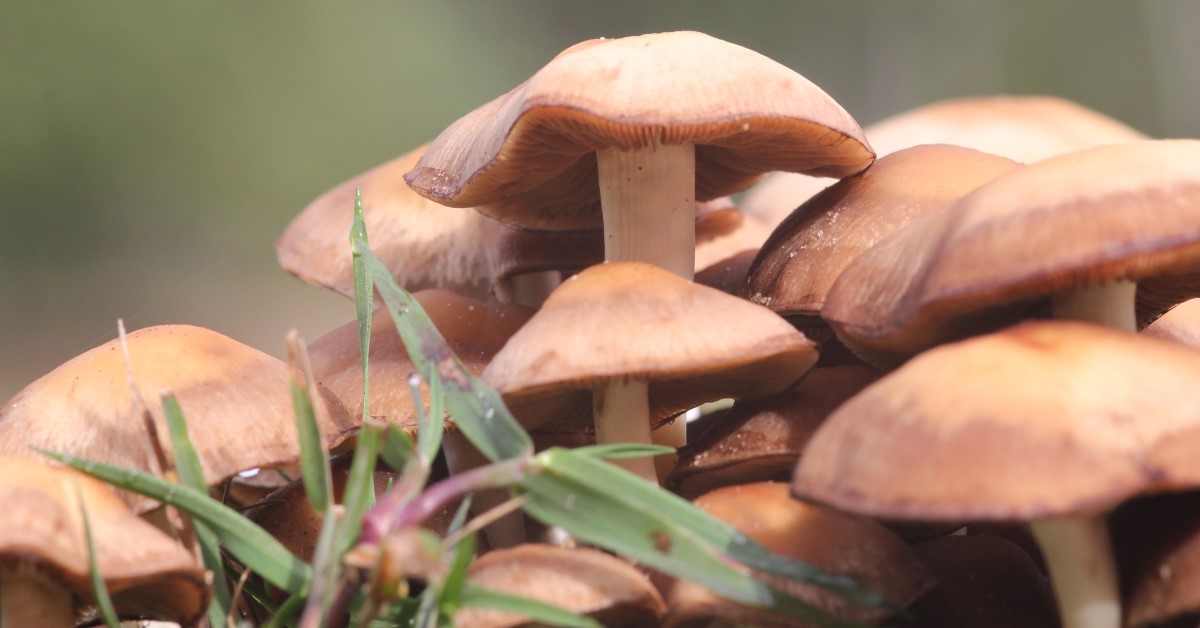Are Wild Mushrooms Poisonous for Pets?
While not all wild mushrooms are toxic to pets, it’s important to prevent your cat or dog from ingesting potentially poisonous fungi.

Pets are naturally curious. When they encounter a mushroom in their yard or while on a walk, there’s a chance they’ll take a nibble. The good news is that less than three percent of mushroom species are dangerous. However, it can still be concerning when your cat or dog consumes a potentially toxic substance.
Let’s take a look at whether mushrooms are safe for pets to eat, and which species should be avoided at all costs.
Can Pets Safely Eat Wild Mushrooms?
The short answer is yes. Most species of mushrooms are safe for dogs and cats to eat. However, that doesn’t mean you should let your dog eat mushrooms you encounter outdoors, since it can be difficult to distinguish an edible mushroom from a toxic one.
For that reason alone, it’s best not to allow your pet to eat wild mushrooms. If your cat or dog does ingest a wild mushroom, contact your veterinarian or the animal poison control center for guidance.
Signs of Mushroom Poisoning in Dogs and Cats
It’s also important to know the signs of mushroom poisoning in pets. Some types of mushrooms can cause severe gastrointestinal (GI) symptoms, such as diarrhea and vomiting. More toxic varieties can lead to tremors, sedation, trouble walking, seizures, and even death.
Other symptoms can also develop if the species is poisonous, such as salivation, lethargy, coma, jaundice, and liver failure. How a toxic mushroom affects your pet will depend on the animal’s age, the type of mushroom, and how much of it was ingested.
Which Mushrooms are Toxic to Pets?
As a pet owner, it’s your job to keep your cat or dog safe from potentially poisonous plants and fungi in the wild. Due to the difficulty of identifying species of wild mushrooms, any ingestion should be treated as an emergency. However, it can be useful to familiarize yourself with the most poisonous kinds of mushrooms.
The following types of wild mushrooms are known to have a serious health impact on pets:
1. Fly Agaric
Amanita muscaria, otherwise known as fly agaric, looks similar to mushrooms seen in children’s storybooks. These mushrooms typically contain a white stem with a red spotted cap.
Fly agaric contains harmful toxins that negatively affect the central nervous system. If ingested, the mushroom can cause symptoms ranging from gastrointestinal upset to seizures and coma.
While they can be found around the world, fly agaric is native to the UK. They often grow in heathland and woodland on light soils. They are most often seen as the weather starts to cool, serving as a sign that autumn is near.
2. Death Cap
Death cap or Amanita phalloides causes the highest number of fatal poisonings in both humans and pets. The fungi features a white cap and an off-white stem. Under the cap are spores that are white and smooth.
This type of mushroom is most commonly found in the UK, Europe, and Ireland. It is most often seen in mixed deciduous woods, particularly under beech and oak trees.
3. Jeweled Death Cap
Jeweled death cap mushrooms also go by the name of Amanita gemmate. They are often misidentified as safe to eat but are actually toxic. They appear with a white stem and yellowish cap with white spots.
This type of wild mushroom mostly grows in forests or other natural areas. They may be found growing individually or in small groups during the late spring or early summer.
Symptoms of ingestion of this mushroom may include nausea and vomiting, followed by possible seizures, jaundice, and coma.
4. Elfin Saddle
Helvella lacunose or elfin saddle appears as a dark saddle-shaped cap with a white stem. They are most commonly found in Ireland, Britain, and throughout Europe.
While there are some species of this mushroom that are known to be edible, most cause negative side effects like upset stomach. This is due to the fungi’s toxic compounds and carcinogenic properties.
Most pets will avoid consuming elfin saddle due to its bad taste. However, if your pet does eat it, it’s important to seek veterinary advice as soon as possible.
5. Autumn Galerina
Autumn galerina, also known as Galerina marginata, is a small brown mushroom with a slightly flat cap. They generally grow in areas where there is decayed wood.
Due to its severe toxicity, symptoms generally begin within hours of ingestion and may include diarrhea, cramps, and vomiting. Over time, symptoms can progress to liver or kidney dysfunction, and in severe cases, death.
What to Do If Your Pet Eats Wild Mushrooms
If your dog or cat ingests wild mushrooms, it’s important to act fast. Start by contacting your vet to determine what you should do next. Your vet will likely want you to bring in a sample of the fungus for identification.
Place the mushroom in wax paper or a paper bag and refrigerate it until you can go to the vet. Avoid the use of plastic bags which can liquefy, deteriorate, or change the color of the mushroom.
Treatment for wild mushroom poisoning will depend on the species but may include inducing vomiting, administration of activated charcoal, IV therapy, and possible liver and kidney management.
Ready to start saving money on pet wellness care?
Then take a look at Mint Wellness, the pet wellness plan that provides fast reimbursement on routine pet care. Save on vaccinations, wellness exams, preventatives, dental, and more!
Learn More


